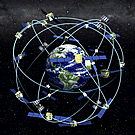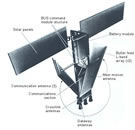High Integrity GPS/ iGPS: Boeing’s Iridium Ace Card
Related Stories: Americas - USA, Boeing, C4ISR, Contracts - Awards, GPS Infrastructure, R&D - Contracted, Satellites & Sensors, Transformation

(click to view full)
In July 2008, the Pentagon announced that Boeing’s Huntington Beach, CA facility would work on a “High Integrity GPS (Global Positioning System) Technology Concept demonstration,” under a $150+ million contract that runs until January 2011.
The European Space Agency has a similar program called EGNOS (European Geostationary Navigation Overlay Service), which is the ESA’s interim step until its competing Gallileo GPS constellation can be built and deployed. EGNOS uses 3 satellites in geostationary orbit, correlating their information with GPS to improve civilian positioning accuracy from 15 meters to 2 meters. In contrast, the USA’s Office of Naval Research contract aims to leverage an existing commercial constellation: the low-bandwidth Iridium constellation of satellites. If their R&D project succeeds, it will create a GPS service that provides quicker positioning fixes, offers improved accuracy for military M-code users, and is more resistant to jamming and other forms of damage.
What is Iridium? Why is this such an important contract? How does a global satellite phone service end up improving the Global Positioning System? Could this program have important commercial spin-offs? DID offers answers, below…
- The Rise and Folly of Iridium
- HI-GPS: A Starring Role in A Different Global Vision?
- HI-GPS: Theory and Practice
- Contracts and Key Events [NEW]
- Additional Readings covering Iridium, GPS, and related developments [updated]
The Rise and Folly of Iridium

In the early 1990s, the Iridium satellite constellation was touted as an example of strategic corporate vision. Its popularity in business schools has gone from strength to strength since then; unfortunately for Motorola, that popularity is now driven by its iconic status as a cautionary tale. The constellation was once part of Motorola’s ambitious plans for a global satellite phone service, with equity partnership arrangements and local landing points all around the world. The initial equipment and service would be expensive, but businesses could afford to pay $3,000 for a phone. Especially it meant that its executives and key projects could truly remain in touch any time, anywhere. In an era of globalized business, Iridium seemed like an idea whose time had come. Motorola took the plunge, even though the system required at least 66 satellites in orbit before it could fulfill its promise.
The single-minded commitment Motorola displayed in making this ambitious vision a reality, turned out to be its achilles heel. Despite its status as a significant manufacturer of mobile phones, Motorola never really reassessed Iridium’s business case once cellular phone infrastructure entered a boom phase all around the world. By the time the constellation had been designed, built, and launched, most urban locations around the globe were already covered by cell phones that offered global connectivity, and didn’t cost $3,000. Worse, Motorola’s offering had issues that included problems with satellite phone reception inside buildings, where business people often need to talk.
Motorola alone lost more than $900 million on the project, and the Iridium service entered Chapter 11 bankruptcy in 1998. Motorola’s engineers were transferred to Boeing for pennies on the dollar, as part of an investment consortium agreement that bought the Iridium service firm in December 2000.
Boeing now operates the 66 satellite constellation, but the Iridium satellites’ tiny bandwidth limits their usefulness. Although Iridium was built as a civilian constellation and remains so, its combination of key advantages and inherent limitations have left it with military voice traffic as a key customer.
The Iridium constellation is expected to remain in orbit until at least 2014, and will be followed by a higher-bandwidth Iridium Next series. These satellites are expected to cost Iridium about $2 billion to deploy, with full availability planned for 2016. The new satellites would be backward compatible with existing Iridium systems, while offering new features and a 5,000x bandwidth increase from 2400 bps to over 10 Mbps.
HI-GPS: A Starring Role in A Different Global Vision?

GPS Block IIA, IIR/M, IIF
(click to view full)
Despite the proliferation of GPS devices in our cars, backpacks, bass boats, iPhones, etc., few people really understand the depth and breadth of GPS’ importance to the world. Bank automatic tellers and stock markets rely on GPS’ ultra-accurate timing service to record the exact times of transactions. Fields are farmed using paths set by GPS. Road and rail transportation networks rely on it for tracking the movement of freight. Some have described the 31 satellite NAVSTAR GPS system as the greatest success in the history of the US Air Force, and one can certainly make a convincing case for that proposition.
On the military side, GPS has become equally ubiquitous. The same freight tracking technologies used by logistics companies are used by the US military to track its own massive, and critical, logistics tail. Tanks use it to track the positions of friendly and enemy units via their Blue force Tracker displays. The soldiers beside them also use it to find their way or report their position using hand-held display units like DAGR. Cruise missiles use it to find their targets, and tail kits like Boeing’s GPS-enabled JDAM can turn any bomb into a precision smart weapon for under $40,000. With the introduction of the M982 Excalibur and M30 GMLRS rocket, even battlefield artillery has come to rely on GPS for guidance.
That proliferation is evidence of success, but it’s also a weakness in any complex system. When so many things are dependent upon just one node or service, the entire system’s stability becomes dependent on just one link in the chain. As the recent Chinese anti-satellite test proved, that link’s stability can’t be taken for granted. When the natural vagaries of cruel fate and chance are thrown into the mix, the rationale for a “high-integrity” GPS system that improves upon the existing constellation becomes clear.
Anyone who has used a hand-held civilian unit also understands the usefulness of faster satellite acquisition and position fixes. Now imagine that people are firing at you, or you’re trying to hide in hostile territory, while obtaining the signal. Jamming resistance is self-evidently useful, and so is improved accuracy.
Lockheed Martin recently beat Boeing for the $1.5 billion contract to build the first set of GPS-IIIA/B satellites, which offer some of these features. On the other hand, the first GPS-IIIA satellite is not scheduled to launch until 2014, older satellites will remain in the GPS constellation for more than a decade to come, and the issue of system robustness will remain no matter who builds the constellation.
Hence the ONR’s interest in the High Integrity GPS research project, also known as iGPS. It aims to leverage one of the things Motorola got right in Iridium: the satellites are very programmable.
HI-GPS: Theory and Practice
The High Integrity/ iGPS team includes Boeing Advanced Systems and Phantom Works, Iridium LLC, Rockwell Collins, Coherent Navigation and experts from academia.
In a way, HI-GPS may hearken back to the early days of space navigation systems. David Whelan, Boeing IDS’ Chief Scientist and its Deputy GM for Advanced Systems, reminded DID of the Naval Research Laboratory and Johns Hopkins’ Transit satellites, which began development in the late 1950s and served until 1996. Transit was a beacon tracking system in Low Earth Orbit (LEO), which relied on the doppler shift of the satellite’s signals to establish positioning.
Under HI-GPS, Iridium’s LEO satellites would work with Medium Earth Orbit (MEO) GPS satellites. Whelan did not specify the exact approaches under investigation, but correlation of GPS positioning with multiple correlated beacon tracking from Iridium satellites might be a useful possibility to study. Others surely exist, and an EE Times article suggested that signal relays that lever the Iridium satellite’s closer low-earth orbits might also be involved. What is certain is that any approach is likely to be based on new signals that can augment GPS, making more satellites available for positioning uses.
These research approaches have 2 key conditions they must meet, however, in order to work. One is that the GPS and auxiliary satellites’ exact positions relative to each other need to be known with some precision. Whelan says that Iridium’s engineering team has worked with Boeing to develop more precise algorithms and approaches for this purpose, and continues to do so.
The other sine qua non is that the satellites’ clocks must all be synchronized with extreme precision. This capability is required for GPS in any event, as the NAVSTAR system relies on correlating distinct, signature signals from each available satellite. To illustrate the scale of the problem, an error or misalignment of just 1 microsecond can introduce a positioning error of up to 1,000 feet. This is why the US Naval Observatory’s atomic clock in Washington, DC has been defined as the “master clock” for the entire GPS system, with subtle corrections made on a regular basis to the atomic clocks on each satellite and ground tracking station. Whelan says that Iridium has now achieved “perfect time,” via a very precise datalink calibration with allowed time channel.
That’s the theory. In practice, HI-GPS remains a research project whose outcome is uncertain. Whelan was adamant about not making any claims for the system just yet, until firm results that can back those claims up have been demonstrated. As a scientist and engineer, he is all too aware that any research engineering project always has some chance of failure.
This is especially true in a military context, where one must contend with the vagaries of enemy action on top of the inevitable engineering challenges. The ESA’s EGNOS is a localized service for civilian use, but the USA’s HI-GPS is envisaged as a global service that will focus on military uses.
If HI-GPS can succeed in meeting its goals by 2011, however, it would offer an important and welcome boost to the NAVSTAR military system. The nature of its approach would make more satellites available, in lower orbits, for very precise positioning uses. That would both improve system speed, and offer precise positioning resiliency if some of the satellites are disabled. All this is likely to be accomplished using a different signal, which would have to be jammed separately in order to fully jam GPS.
Which leaves the final question: what about the civilian front? Projects like EGNOS have proven that improved positioning has civilian value too, especially as GPS continues to embed itself in a wide range of civil technologies and functions. Whelan said that Boeing has asked itself whether HI-GPS would also have commercial value. The answer to that question can only be “yes.”
Converting a military research project to civilian use would require multiple approvals, however, from the project’s sponsors at ONR, to America’s National Executive Committee for Space-Based PNT, to possible approvals from national agencies like the Commerce Department, Department of Transportation, et. al. Issues of proven safety, as well as inherent issues of an enhanced global civilian signal’s usefulness as a military weapon, would certainly be raised. Then again, the rise of competing PNT/GPS systems may make the point moot by offering the same capabilities.
For now, civil adoption remains a long way off, and even military adoption is uncertain. What can be said with certainty, however, is that the idea behind HI-GPS is one that shows a lot of promise on both military and civilian fronts. This is a project worth watching.
Contracts and Key Events

(click to view full)
July 13/09: Per an Iridium/Boeing release, High Integrity GPS reaches 2 major milestones for the U.S. Naval Research Laboratory.
The first milestone involves on-orbit Enhanced Narrowband (ENB) software modifications to the Iridium constellation. Second-generation GPS-aiding signals can now be broadcast throughout the entire Iridium constellation. The team completed the ENB software upgrade on schedule and within budget, and will support a system-level demonstration later in 2009.
The second milestone was a demonstration in which a receiver on a moving vehicle used the technology to acquire a GPS signal, despite hostile jamming. David Whelan, Boeing IDS chief scientist and Phantom Works Deputy General Manager, explains why this matters:
“When a military GPS receiver is jammed, it cannot obtain a position fix, and movement only makes the situation worse. Even from a cold start, it took only minutes for the High Integrity GPS-aided receiver, in a moving vehicle, to receive the GPS signal while being jammed. Without assistance from the High Integrity GPS system, a position fix would never have been obtained.”
July 18/08: The Pentagon announces that Boeing’s Huntington Beach, CA facility will work on a “High Integrity GPS (Global Positioning System) Technology Concept demonstration,” under a $153.5 million cost-plus-fixed fee completion contract that runs until January 2011 (N000173-08-C-2074).
Work will be performed in Huntington Beach, CA (34.3%); Philadelphia, PA (17.3%); St. Louis, MO (1.5%); El Segundo, CA (12.6%); Cedar Raids, IA (12.3%); Bethesda, MD (15.3%); Washington, D.C. (5.4%); Ithaca, NY (0.5%); Chicago, IL (0.3%) and Burlingame, CA (0.5%), and is expected to finish in January 2011. This contract was competitively procured under Naval Research Laboratory Broad Agency Announcement 68-07-01. See also Boeing release | EE Times: “Boeing aims to combine GPS, Iridium orbiting networks.”
Additional Readings: Related
- Iridium official site. There were originally supposed to be 77 satellites in the constellation, which is the atomic number of Iridium. Hence the name. Dysprosium corresponds to atomic number 66; it is one of the most magnetic substances known, and is excellent at absorbing neutrons. But a bankrupt company isn’t about to hold a do-over after spending almost $200 million marketing “iridium.”
- DID (June 7/09) – $21.7M for Phase II of Netted Iridium Program. Designed to offer a wireless “push to talk” service to mobile forces.
- Info World (Feb 16/07) – Iridium plans next-generation satellites. This is the planned “Iridium Next” constellation.
- Dartmouth college, Tuck School of Business – Learning from Corporate Mistakes: The Rise and Fall of Iridium (see also PDF version). A compelling cautionary tale from the corporate sector that illustrates the perils of not re-examinaing and challenging one’s assumptions in the middle of the process. Motorola did not. Result: Iridium’s market didn’t need it any more, but Iridium didn’t have the bandwidth to do much else. Motorola took a $1 billion loss, and Iridium became one of the 20 largest bankruptcies in US history.
- DID (April 17/06) – US Military Pays $80.4M for Iridium Services
- CNET News (Dec 12/2000) – [New] Iridium owners optimistic about new satellite focus
- Chicago Tribune (Oct 31/2000) – Iridium Supports $25 million Bid: deal could save satellite system. Note Boeing’s role in the transaction.
- Government Computer News (Nov 9/1998) – DISA establishes portal for telecom satellite system. Iridium, of course.
Additional Readings: GPS and Competitors
- USAF Space Command, High Frontier Journal (May 2008, Vol 4, #3) – Space-Based Positioning, Navigation, and Timing special issue [PDF format]. Probably the best depth introduction for laypeople looking to understand GPS’ role, challenges, and future plans.
- Vector Site – US Navigation Satellite Systems. From Transit to GPS.
- DID (Aug 24/05) – The GPS Constellation: Now and Future
- Crosslink Magazine (Summer 2002) – Modernization and the Move to GPS III Excellent summary of GPS III’s planned improvements as of that date.
- The Aerospace Corp. FFRDC – GPS Primer – The Global Positioning System: An Amazing Tool
- Astronautix.com – Navstar. Overview of the entire program, plus dates.
- DID FOCUS – Galileo GPS Project Faces More Certain Future. Includes readings covering security-related issues, and China’s own GPS projects. China is also a member of the Galileo consortium.
